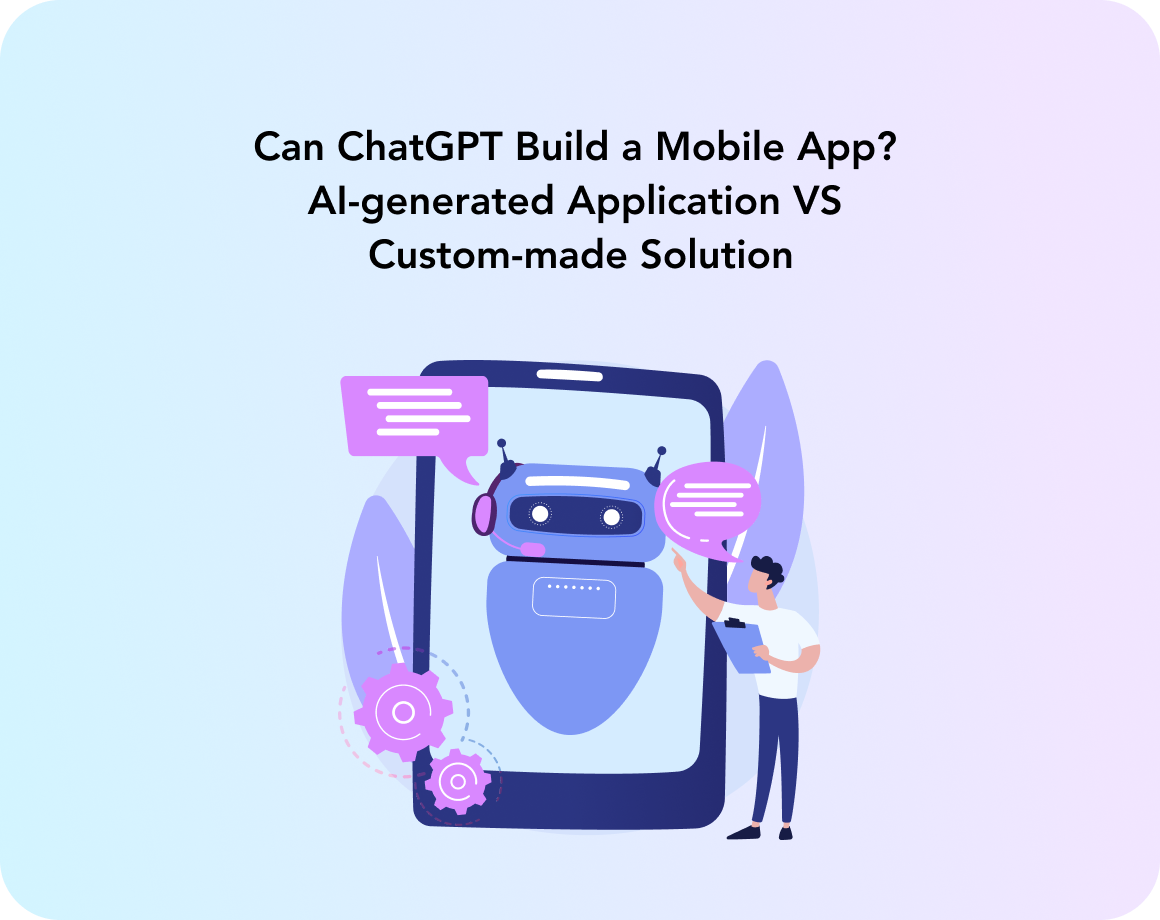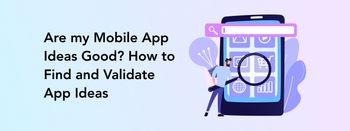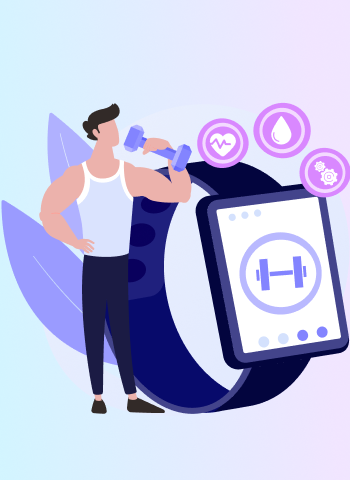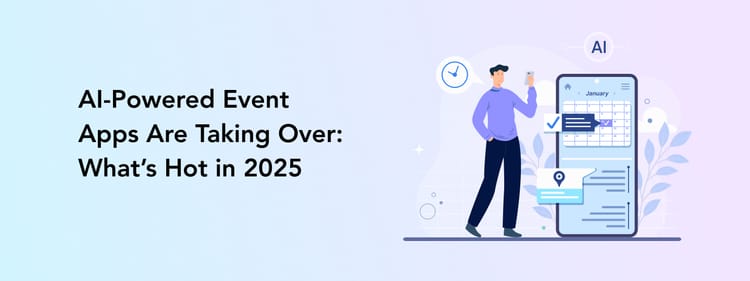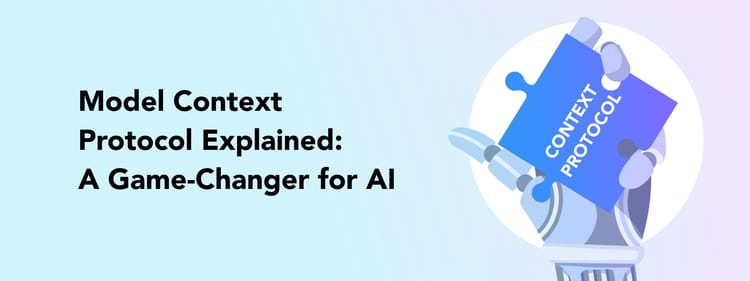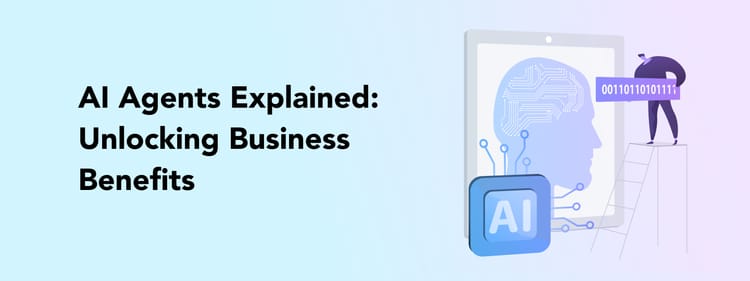If you read some of the claims about ChatGPT online, you might get an idea that this AI tool can do practically anything, from writing emails to doing your laundry. Joking aside, ChatGPT can perform a variety of online tasks, like coming up with business ideas, conducting research for your content, or even doing code reviews.
But can ChatGPT build a mobile app from scratch, from creating an app concept to writing code? More importantly, what quality of a mobile application can ChatGPT offer and how would the final product compare with the solution built by a professional development team?
In this article, we explain how ChatGPT works, explore its app-building capabilities, and look at the AI-created vs professionally-made mobile applications.
How does ChatGPT work?
Before we get to ChatGPT’s functionality scope, let’s take a deeper dive into how this AI tool actually generates its responses. ChatGPT is a language model that is trained on a large amount of available data. If the previous versions of this AI tool could only access a limited scope of training data “fed” to ChatGPT, the current system can surf the Internet freely and use any information online for coming up with answers.
To make sense of the data found online, ChatGPT uses a deep learning algorithm called the Transformer architecture. It uses a pre-trained model called GPT-3.5, which has been fine-tuned on a wide variety of language tasks such as text completion, translation, summarization, and question answering.
ChatGPT breaks any text, either entered by you or from training data into tokens. These are meaningful chunks of text, usually words. The tool uses tokens and the relationships between them to break down meanings and create responses from scratch. ChatGPT basically makes predictions as to which token has to go next based on the data the system knows.
ChatGPT is trained to provide unique, natural-sounding, and context-sensitive responses but it’s important to understand that any AI output is based on the existing information online. As a result, any biases, manipulations, or fake facts can be repeated by ChatGPT. Of course, none of the ideas the tool offers you are unique either.
How to build a mobile app with ChatGPT
Now that you know how ChatGPT actually comes up with its suggestions and advice, let’s see what it can offer us when it comes to building an app. The main question is “Is it possible to build a functioning application from scratch as a non-technical person with ChatGPT?” Well, let’s try.
App idea and feature set
First things first, let’s ask ChatGPT to come up with the app concept and feature set. Suppose you are planning to launch a fitness app. Let’s ask ChatGPT to create a concept of the future solution.
We received a list of features to include in our application. Not bad, all of them seem legitimate and really necessary for a fitness app. But is this feature set different from any other fitness app out there? How do we stand out against the competitors? Let’s try to ask a different question.
AI is suggesting virtual reality. Seems interesting but is it applicable for a daily use mobile fitness app? Not many fitness app users would find a VR set to be accessible. What’s more, virtual reality development can be way above our budget.
To finish coming up with the app’s basics, we need a name and branding.
UI/UX design
Having all the features and branding in our hands, let’s work on the details. ChatGPT is a text-based tool, so it cannot provide us with ready-made UI components and mockups. We will have to complete this task through a separate editing tool or simply use a drag-and-drop constructor.
Still, we can at least ask ChatGPT to share some color palettes and font suggestions to have a complete app's visual identity.
While as a text the UI suggestions seem appropriate for our app, implementing those into a full-fledged UI/UX project is another task. For those who are not familiar with the design tools, like Figma, it can be quite a challenge to create an app design.
What’s more, ChatGPT won’t do much for the app navigation, journey map, or information architecture as visual representation is a must for these processes. ChatGPT can offer you a text version of a journey map but organizing these steps harmonically and logically is above its capabilities.
After all, UI/UX design is all about visuals, so it is practically impossible to get high-quality app design advice from a text-based tool.
Coding
Suppose you managed to assemble all the AI's UI/UX recommendations into a working concept with the help of a graphic editor or drag-and-drop constructor. How do we turn the visualization into a real, working application? Let’s ask our favorite robot.
Again, while giving a list of steps to follow for building an Android app from scratch, ChatGPT is not getting into details of how to actually perform each step. Let’s try getting the instructions for the first step of our app building.
Some of the developers did a similar experiment asking ChatGPT to build a mobile app step by step, including writing code and debugging it. We won’t go through all the stages of the Android app development process; from the experience of other developers and organizations, it is possible to create a very basic application with ChatGPT.
At the same time, building a well-functioning and feature-rich app with attractive UI elements is a different matter, so far not doable by ChatGPT.
ChatGPT application vs custom made solution
While ChatGPT can be a great assistant for advanced Google searches, like answering the questions arising during the development process, offering ideas, and conducting research, its capabilities right now are far from competing with a professional app development team.
There are several critical points that hold the app created by ChatGPT back:
- The app concept and feature set are not original but based on similar existing solutions
- ChatGPT doesn’t conduct preliminary research, such as competitor analysis or user persona creation to offer a compatible, user-centered solution
- ChatGPT cannot create a viable UI/UX design with a prototype visualization
- ChatGPT cannot perform user, A/B, or any other method of design testing
- ChatGPT cannot build an app based on a custom UI/UX design and integrate complex elements
- You need to have basic expertise in UI/UX design and app development to use ChatGPT’s suggestions
Taking all these points into consideration, it is clear that if your goal is a competitive app that is both highly functional and visually attractive, a professional development team is the way to go.
To compare what ChatGPT offered as a fitness app concept and realization, let’s take a look at one of the fitness app projects we completed at Perpetio.
How does this app differ from the one offered by ChatGPT? Some of the key points are
- Research-based design decisions; each feature is introduced to satisfy a particular audience and meet their pain points
- Well-structured app with pre-decided navigation based on a completed journey map and information architecture
- Balanced, aesthetic UI elements with a distinguished app style and branding
- Bug-free cross-platform app development
- Complex monetization strategy to both retain users and make a profit
Overall, ChatGPT can be a tool for experiments and idea gathering but it is better to trust a real development company with creating a viable solution for a market release.
Choose Perpetio as your reliable partner
If it seems like your ambitions for market success are higher than making an average application that doesn’t stand out from the competitors, Perpetio is here to help you out.
From researching your potential audience and making sure your app delivers exactly what they need to helping with the launch of a final product, the Perpetio team will support your efforts at every stage of mobile app development. We don’t simply write code: we focus on a holistic approach and offer free consulting in the process, so the app delivered matches your business goals.
Perpetio is open to new mobile app design and development projects — let’s build a great product together!
